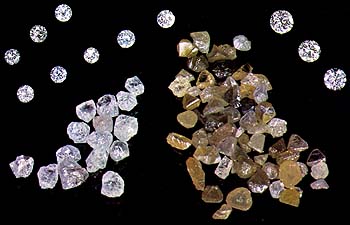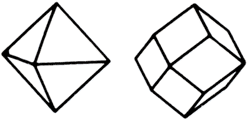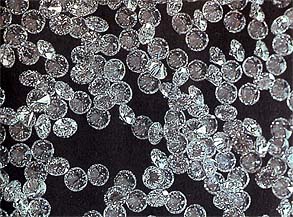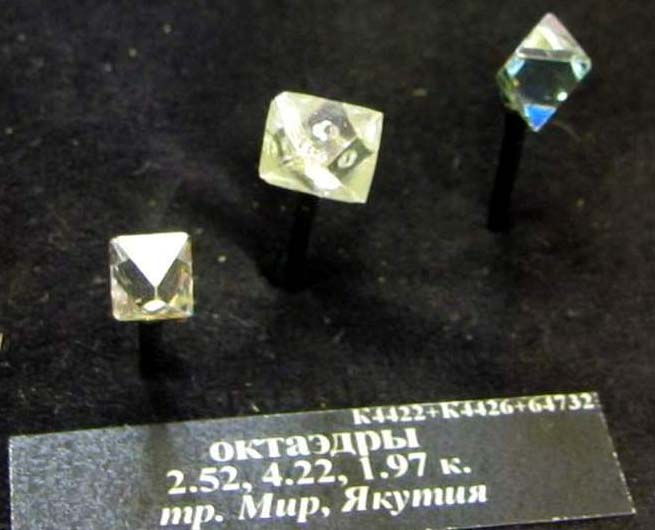Stone, minerals and semiprecious of the world stone
Native elements: Diamond -->rus
 Diagnostic cart.
Diagnostic cart.
On a photo. Brait from Aleksander Bey (Namibia)
C
Crystal structure cube
Hardness on the Mohs scale 10
Specific unit weight mass 3,52
Cleavage perfect absolute on octahedron
Fracture, break padman
Colors colourless
Colors in powder triturate white
Glance (glitter, glare) diamond

 A diamond got the name for his hardness (from Greek. "adamas" - irresistible). Nothing not to be compared with by him on hardness, and that is why it in truth is eternal. Hardness on the Mohs scale diamond at polishing in 140 times higher, than at a corundum. However, on the different verges of crystal hardness of diamond a few different. It allows to polish a diamond a diamond, more faithful, by diamond powder, which particles of any hardness, possible for a diamond are century It is necessary to mean that perfect absolute cleavage on octahedron requires the special carefulness at the sealing-off of diamond in a frame. Very strong brilliance serves as a diagnostic sign on which the trained eye is distinguished by a diamond from imitations (complications can be only with "fianite" - artificial diamond-like gemstone).
A diamond got the name for his hardness (from Greek. "adamas" - irresistible). Nothing not to be compared with by him on hardness, and that is why it in truth is eternal. Hardness on the Mohs scale diamond at polishing in 140 times higher, than at a corundum. However, on the different verges of crystal hardness of diamond a few different. It allows to polish a diamond a diamond, more faithful, by diamond powder, which particles of any hardness, possible for a diamond are century It is necessary to mean that perfect absolute cleavage on octahedron requires the special carefulness at the sealing-off of diamond in a frame. Very strong brilliance serves as a diagnostic sign on which the trained eye is distinguished by a diamond from imitations (complications can be only with "fianite" - artificial diamond-like gemstone).
Diamond on composition is a clean carbon. It hardest mineral from all to us known, but simultaneously and fragile frail brittle. Glance (glitter, glare) at a diamond very bright, almost metallic, him the best of all to name "diamond". Many crystals can show a capacity for luminescence in ultraviolet rays. In most cases crystals have a form of octahedron and octahedron (48 three-cornered verges), often with the distorted surfaces. On the verges of octahedron quite often it is possible to look after a "screw-thread" as triangles which name trigone. Due to a double two octahedrons can form a flat crystal as the distorted triangle.
A diamond is very steady chemically; only chromic mixture (mixture of the saturated solution of bichrome and concentrated sulphuric acid) at 200oC oxidizes him, translating in carbon dioxide. At high temperatures on-the-spot фасет the figures of etch appear. It requires a carefulness at soldering of jeweller wares with diamonds. Unlike alike minerals and synthetic products a diamond is transparent for Roentgen X-rays beam.
In 30th it was found out XX century existence of a few types of diamond, which differentiate the spectrums of absorption, luminescence, conductivity, degree of perfection of cleavage. It is now accepted to select four types of diamond. Type of diamond in any way does not influence on his value, but it is necessary to take into account him at cutting. Extraordinarily attractive optical effects due to which it and reputed "king" of jewels are inherent a diamond. In jeweller decorations a diamond is used from the most ancient times.
Diamond is painted in a bluish, rather yellow or brown color. Transparency is observed not always, it is limited by the microcrystalline varieties of black (carbonado) and formation of fibred-radiant structure (side). The sizes of crystals can be varied in very wide limits - from the stakes of millimetre measuring and weight in milligrams, to many centimetres and weighing to 621 g (3106 carat), as at the diamond of "Kullinan".
Diagnostic indication.
Diamond due to such signs, as a game of light (chromatic dispersion of light, caused an internal reflection), and also to high hardness, it is impossible to entangle with any known mineral.
Origin provenance genesis.
Diamonds appear on depths in a few hundred kilometres, in that part of the earth's crust which is named a mantle. Nearer to the surface they appear as a result of the volcanic moving of rock, rich in olivine. It is named a kimberlite on South African locality of Kimberli.
Deposit minefield mine and use.
Distinguish primary and second deposits. In the first diamonds are celled in the layer of maternal rock - kimberlite. In the second under the action of erosion they moved away from a kimberlite and carried water-courses. Most ancient from the known developments of diamond (now neglected) are in Indo-chinese. In 1725 deposits are opened in Brazil, in 1867 - in South Africa (Kimberli). In 1950th unique deposits are opened in Siberia, in 1970 - in Australia. Deposits are known on Borneo and Venezuela.
Due to the hardness a diamond is used as an abrasive (for cutting of glass and for re-enforcement of borings heads for well-drilling). Widely used on jeweller business, where fourth part of world booty of diamond goes approximately.
 Use is on jeweller business.
Use is on jeweller business.
Basic dignity of diamond as a jewel is absence of color and extraneous admixtures. Accordingly, the painted differences (bluish, rather yellow and brownish) less than are valued. Stone assort, and diamonds which do not fit for cutting are used for making of diamond instrument. If cutting is executed professionally, stone has a good game of light. If cutting is bad, it is necessary to redo; thus a diamond loses in weight and accordingly in a price.
Diamond cut, getting Diamond (this term is wrong applied for denotation of mineral, although it is used exceptionally for denotation of the rounded cutting with 58 fasings, which can be done for any semiprecious stone). At such treatment goodcleavage helps on octahedron.
Part of this octahedron (two rectangular pyramids, imposed on each other) retires, to get the large verge of diamond ("table top") and finishing overhead fasing. It is necessary to delete five ninth overhead pyramid and one ninth нижней. For treatment of fasings use diamond powder which is got from a side or carbonado. Except for the enormous number of variants of the classic cutting a diamond, the great number of other types is used - among them emerald, ditrigonal, oval, стелла, table top and other
In 1905 in Transvaale (South Africa) was found out the diamond of exceptional size (3106 carat). This diamond and self deposit got the name "Kullinan" on the name of proprietor of mine T.V. Kullinana. From a stone cut 36 semiprecious stone. Among them "Kullinan" I and "Star of Africa" (530 carat), which entered in the number of valuables of the Britannic crown, and "Kullinan" II (317 carat). There are yet famous diamonds appearance of which is surrounded legends: a blue diamond "Khoup" (45 carat), kept in Smitsonovskom institute in Washington, precursor of great number of hoodoos; greenish stone from Drezdena, being in the museum of Gryune Gevol'be ("Green Dome"); "Regent" (137 carat) and "Sansi" (55), purchased Lui XIV and kept in Louvre in Paris; "Koh-I-nore" (108 carat), being in Tauere in London (EU).

Diamond. World, tube, Yakutiya, Russia, CIS. A photo: © A.A. Evseev.
